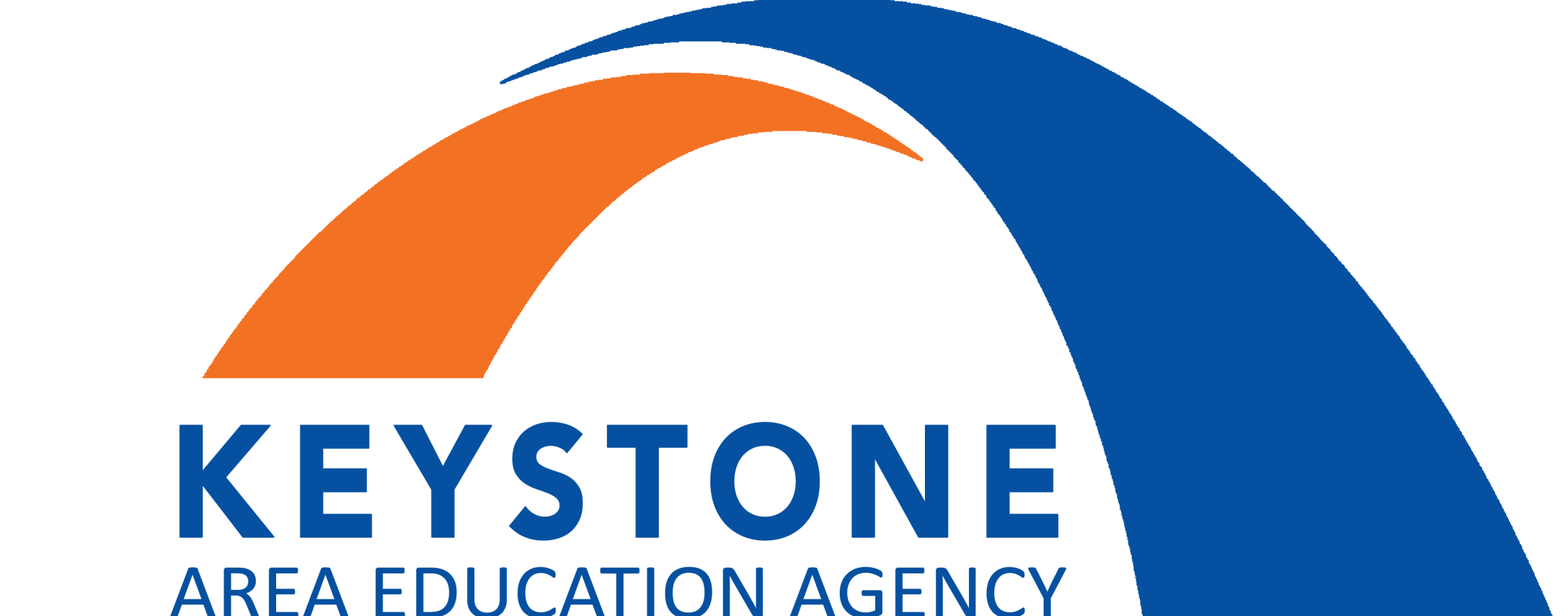
Learn more about Literacy Standards at all grade levels. Welcome! This site provides resources for all areas of literacy.
Reading Standards
Writing Standards
Speaking and Listening
Iowa Early Learning Standards
Literacy Contacts
Courtney Bentley
School Improvement Facilitator
cbentley@keystoneaea.org
563-447-0898 or 800-632-5918
Tracy Grimes
School Improvement Facilitator
tgrimes@keystoneaea.org
563-241-3088 or 800-632-5918
Lisa Andreasen
School Psychologist
landreasen@keystoneaea.org
319-214-0168 or 800-632-5918
Holly Fish
School Improvement Facilitator
hfish@keystoneaea.org
563-241-3813 or 800-632-5918
Annette Hyde
Administrator of Special Education Services
ahyde@keystoneaea.org
563-447-0784 or 800-632-5918
Sherri Imoehl
School Improvement Facilitator
simoehl@keystoneaea.org
563-241-3380 or 800-632-5918
Tesha Moser-Zimmermam
Administrator of Educational Services & Associate Administrator
tmoser@keystoneaea.org
563-214-9949 or 800-632-5918
Daniel Zaccaro
School Improvement Facilitator
dzaccaro@keystoneaea.org
563-241-3279 or 800-632-5918
Phonemic Awareness
What is Phonological Awareness/Phonemic Awareness?
Phonological Awareness is a broad skill that includes the ability to hear, isolate, discriminate, and manipulate individual sounds or sound combinations. This includes identifying syllables, words, and onsets and rimes. Phonemic awareness refers to the specific ability to focus on and manipulate individual sounds (phonemes) in spoken words. All children should receive phonemic awareness instruction within their early literacy core. Some students may require additional instruction regardless of age.
Difference between Phonemic Awareness and Phonics
~www.readingrockets.org~
Instructional Routines
Directly teach the following skills in a consistent routine (click links below):
Substituting Phonemes Routine
Courtesy of Florida Reading Research Center and Wisconsin RTI Center.
Materials From Keystone Media Library
Data & Assessment
Classwide intervention should be considered when Universal Screening data indicates that ≤ 60% of the class is proficient in the following subtests:
- FASTBridge: Onset Sounds, Letter Sounds, Word Segmenting
- DIBELS 8th Edition: First Sound Fluency (FSF) and Phoneme Segmentation Fluency (PSF)
Classwide Intervention Considerations
- Were you consistent with implementing the classwide intervention?
- Did you or how will you monitor student progress?
- Did your class as a whole make progress on this skill?
- Should you embed this intervention or routine into your core instruction?
- Are there some students that continue to struggle? If so, read on…
Individual characteristics of students who struggle to do one or more of the following:
- Rhyme
- Identify syllables within a word
- Segment words into parts (no text presented)
- Identify the first, last and medial sounds they hear
Diagnostic Assessments to guide instructional planning
- Diagnostic Tools – Coming Soon
- Simple Phonemic Awareness Assessment (courtesy of Wendy Robinson-PDF version)
Considerations for intensifying:
The routines and instruction listed above can be intensified with these considerations:
- Allow opportunities for practice over time (not just “one and done”)
- Multi-sensory components will help solidify concepts (coins, claps, movement, pictures, etc.)
- Increase time, decrease groups size
- increase opportunities for reinforcement and feedback
It’s never too late to address PA. Sometimes older students need to learn these skills in order to build their reading skills!
Example of intensified lesson of combined skills (1:1)
How do you know it’s working for the students who received intensified instruction?
Student Can…
- Orally produce rhyming sounds and words
- Orally identify the first and last letter sounds in a spoken word
- Orally identify the medial sound in a word
- Blend sounds together to form a whole word? (e.g. /s/ /i/ /t/ becomes sit)
- Orally segment words into individual phonemes? (eg. cat becomes /c/ /a/ /t/)
- Can show sufficient skills on a phonemic awareness assessment or FASTBridge Early Reading assessments
Phonics
What is Phonics/Decoding?
Phonics is the relationships between the letters of written language and the sounds of spoken language. Children’s reading development is dependent on their understanding of the alphabetic principle — the idea that letters and letter patterns represent the sounds of spoken language. (www.readingrockets.org)
Linda Farrell, M.Ed
~www.readingrockets.org~
Fluency/Syntax
What is Fluency/Syntax?
Fluency is the ability to read orally with accuracy, speed, and expression in order to demonstrate effortless reading.
Syntax is the arrangement of words and phrases to create well-formed sentences. Fluent reading of phrases and sentences is essential to the learning process. According to Wolf (2001), fluency directly contributes to three critical learning outcomes:
Retention: the ability to perform a skill or to recall knowledge long after formal learning/training has ended,
Stamina: the ability to maintain performance levels for extended periods of time, and
Generalization: the ability to combine and apply what has been learned to perform more complex tasks creatively and in new situations.
~www.readingrockets.org~
Instructional Routines
Provide opportunities for frequent practice and modeling of fluency skills (click links below)
Repeated Reading
Partner Reading
Choral Reading
Fluency Flags
Data & Assessment
Classwide intervention should be considered when Universal Screening data indicates that ≤ 60% of the class is proficient in the following subtests:
- FASTBridge: CBM-R (additional interventions can be found under training and resources)
- DIBELS 8th Edition: DIBELS Oral Reading Fluency (ORF)
- AIMsWEB: R-CBM
Classwide Intervention Considerations
- Were you consistent with implementing the classwide intervention?
- Did you or how will you monitor student progress?
- Did your class as a whole make progress on this skill?
- Should you embed this intervention or routine into your core instruction?
- Are there some students that continue to struggle? If so, read on…
Individual characteristics of one or more of the following:
- Is accurate (95% or better), but the rate is below expectation.
- A diagnostic assessment reveals decoding sub-skills are intact and can be ruled out as a cause.
- Most of the time, this is 3rd grade+
Diagnostic Assessments to guide instructional planning
Considerations for intensifying:
The routines and instruction listed above can be intensified with these considerations:
- Allow opportunities for practice over time using varied text (poetry, literature, comics, readers theatre, etc.)
- Resource from Iowa Reading Research Center – Varied Practice Passages from 4th grade study
- Increase time, decrease groups size
- increase opportunities for reinforcement and feedback
- Individual goal setting
How do we know the intensification is working?
Frequent progress monitoring would indicate the student’s rate of progress over time. In order to close the achievement gap, a student should progress at a rate that is greater than the grade level norms.
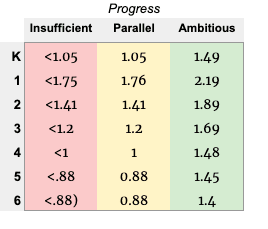
Fluent readers are better able to comprehend because they process information quickly (LaBerge & Samuels, 1974).
Comprehension
What is Comprehension?
Comprehension goes beyond reading the text on the page – it involves finding meaning in the text and being able to summarize, reiterate, and apply what has been read. Successful reading comprehension requires text comprehension, vocabulary knowledge, and reading fluency. If the student cannot recognize and understand the individual words on a page, then he or she will struggle to make sense of the text as a whole. Students with well-developed comprehension skills are able to understand both the main idea and the details of any given text, and they are able to identify the different components of the text as well. Comprehension is an interactive process that occurs not only while a student is reading the text but afterwards, as well. It consists of the ability to make inferences from a passage and use critical thinking skills to answer questions related to the text. Comprehension skills must be taught and reinforced over an extended period of time to ensure that your child can master reading comprehension.

Comprehension Strategies research
Instructional Routines
Provide the frequent opportunities and modeling of following strategies:
Text Structures
Understanding how a text is structured helps students to better understand the purpose of the writing, understand the central ideas, and to comprehend details of the material when reading expository texts. Common text structure types include: description, sequence, problem/solution, cause/effect, and compare/contrast. It is recommended that they are introduced and taught in that order. This strategy can be used in both large and small group instruction. Length of time needed for the strategy will vary depending on the students’ acquisition of the skills and the number of steps completed in a day.
Summarization (Taken from Reading Rockets)
Summarizing teaches students how to discern the most important ideas in a text, how to ignore irrelevant information, and how to integrate the central ideas in a meaningful way. Teaching students to summarize improves their memory for what is read. Summarization strategies can be used in almost any content area. Summarization can be used K-12 and with either large or small groups or 1:1. Time will depend on length of passage and quality of discussion.
Canned Questions
Canned Questions offer a way for students to respond to questions at the various cognitive levels of Bloom’s Taxonomy. Students, in partners or small groups, have the opportunity to work through questions that range from lower to higher levels of thinking. This can be done with any age of student, and would be considered a large-group general education strategy, or a supplemental routine in smaller group. This is not an intensive strategy.
KWL
K-W-L+ can be modified to any content area or grade. It emphasizes what students know, what they want to know, and what they learned. This graphic organizer can be used with a whole class, small group, or an individual as a pre-, during-, and post-reading strategy. K-W-L+ generates background knowledge, sets a purpose for reading, and transforms information, writing, and talking.
It Says – I Say – and So
Graphic organizer that helps locate information in a text and put it together with what you already know to arrive at a complete answer. Could be used in a large or small group.
Question/Answer Relationship (QAR) (Taken from Reading Rockets)
The question–answer relationship (QAR) strategy helps students understand the different types of questions. By learning that the answers to some questions are “Right There” in the text, that some answers require a reader to “Think and Search,” and that some answers can only be answered “On My Own,” students recognize that they must first consider the question before developing an answer.
Magnet Summaries
Magnet Summaries help students “rise above the details to construct meaningful summaries in their own words.” Students identify magnet words (key concepts/terms from their readings), attach appropriate details to each magnet, and then combine their ideas in writing. This strategy can be used with any grade level, K-12.
Paragraph Shrinking
The paragraph shrinking strategy allows each student to take turns reading, pausing, and summarizing the main points of each paragraph. This strategy is designed to be used in pairs, and is applicable for grades K-8. This strategy will take approximately 6- 8 minutes to group students, assign tasks and complete the tasks.
Round Table
The Round Table strategy is for the recall of information through student engagement of nonfiction text. It allows students to practice listening, recall, and writing skills. Dictated writing is applicable for all grade levels as a class wide strategy; time is variable depending on text size.
Spider Web Discussion (Secondary level)
It is a whole class discussion guided only by the students with no input or direction from the teacher. The entire class gets the same grade (in the gradebook, but no count) based on pre-established criteria and post-discussion debriefing. What does the teacher do? Write all the students’ names on a paper and note where they are sitting, listen to the discussion, and draw lines from one speaker to the next.
Data & Assessment
Classwide intervention should be considered when Universal Screening data indicates that ≤ 60% of the class is proficient in the following subtests:
- FASTBridge: areading (additional interventions can be found under training and resources)
- DIBELS 8th Edition: Maze
- AIMsWEB: Maze
Classwide Intervention Considerations
- Were you consistent with implementing the classwide intervention?
- Did you or how will you monitor student progress?
- Did your class as a whole make progress on this skill?
- Should you embed this intervention or routine into your core instruction?
- Are there some students that continue to struggle? If so, read on…
Individual characteristics of students who struggle to do one or more of the following…
- May read fluently, but is unable to articulate what they read.
- May read with high accuracy but cannot retell.
Diagnostic Assessments to guide instructional planning
Diagnostic Tools List: Coming Soon
Considerations for intensifying:
The routines and instruction listed above can be intensified with these considerations:
- Allow opportunities for practice over time using varied text (poetry, literature, comics, readers theatre, etc.)
- Increase time, decrease groups size
- increase opportunities for reinforcement and feedback
- Individual goal setting
How do we know the intensification is working?
Frequent progress monitoring would indicate the student’s rate of progress over time. In order to close the achievement gap, a student should progress at a rate that is greater than the grade level norms.
Examples of progress monitoring tools you can use:
- DIBELS 8th Edition: Maze
- AIMsWEB: Maze
- EasyCBM: Passages
Informal Observations such as:
- Student can describe the main idea of a story
- Student can predict what will happen next
- Student can summarize or retell parts of the story
- ETC.
Vocabulary
What is Vocabulary?
Vocabulary is a set of familiar words within a person’s language, which usually develops with age. It serves as a useful and fundamental tool for communication and acquiring knowledge. Instruction to improve vocabulary should include meaning (morphology) and origin of the word.
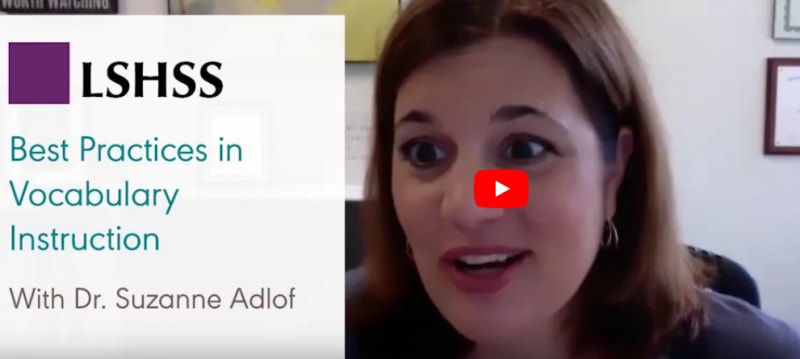
American Speech-Language-Hearing Association
https://pubs.asha.org/journal/lshss
Instructional Routines
Provide the frequent opportunities and modeling of following strategies:
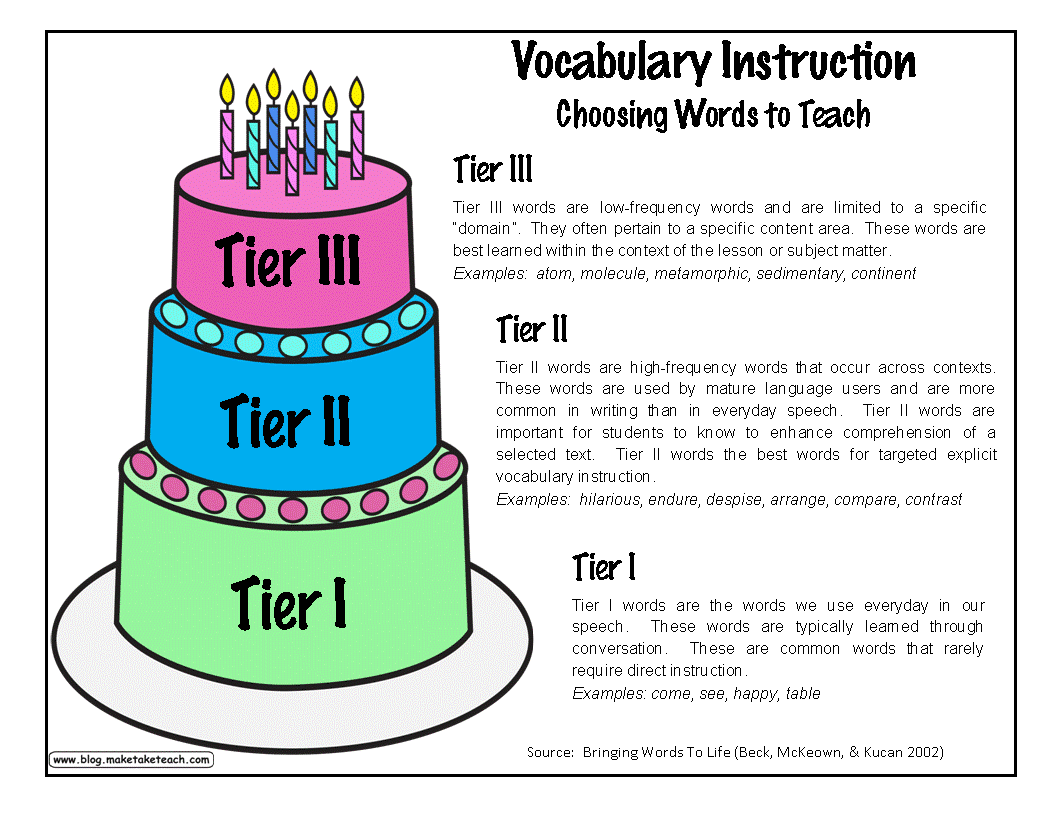
Frayer Model
The Frayer Model is a strategy that uses a graphic organizer for vocabulary building. This technique requires students to (1) define the target vocabulary words or concepts, and (2) apply this information by generating examples and non-examples. This information is placed on a chart that is divided into four sections to provide a visual representation for students.
This instructional strategy promotes critical thinking and helps students to identify and understand unfamiliar vocabulary. The Frayer Model can be used with the entire class, small groups, or for individual work. The Frayer Model draws on a student’s prior knowledge to build connections among new concepts and creates a visual reference by which students learn to compare attributes and examples.
Vocabulary Analysis
This strategy teaches secondary students to take a multi-syllable words apart and use the meaning of the parts to determine the meaning of the word. It uses individual, group and partner work to come to a general understanding of the word. The strategy provides the students with lists of affixes and some root words and provides their definitions. It also provides a suggested way for the students to organize their notes (systematic procedure/routine). Time will depend on number of vocabulary words provided.
Data & Assessment
Typical improvement in vocabulary will be indicated by an increase in comprehension scores. Please click Comprehension to review Data and Assessment.
Writing
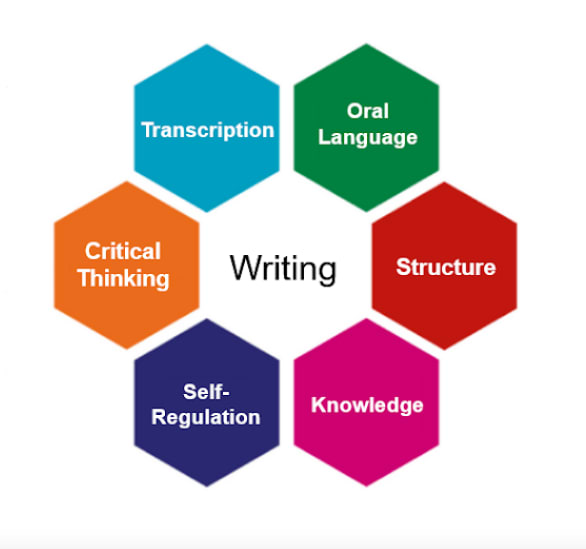
Writing is one of the most difficult tasks we do in school. It requires the adept integration of a number of skills. When students are first beginning to write, transcription, oral language, and basic reading skills are all necessary. Over time, while these skills still play a role, the higher level skills of self-regulation, critical thinking, and writing knowledge come into play.
Overview Document
36 Evidence Based Practices For Writing Instruction and the companion article from the CEEDAR Center.
Instructional Routines
Transcription
Transcription skills are needed to physically get thoughts down on paper. Learning the basic skills of letter formation and spelling to automaticity is what will free the brain to focus more on the meaning the writer wants to convey. While many associate these basic skills with early elementary school, research has shown that they continue to affect writing quality in the upper grades as well (Kent & Wanzek, 2016).
- Handwriting/Keyboarding fluency
- Spelling
- Mechanics
Ways to improve to writing
follow link to download an article written by Steve Graham in the American Educator Winter 2009-2010.
https://www.aft.org/ae/winter2009-2010/graham
Instructional Routines to Support Transcription
Early writing:
- Developmental stages: Pre-strokes
- Every Child is a Writer
Writing routines to encourage automaticity/fluency of writing
- Primary Multi-sensory writing routines
- Ways to Learn letters without using a pencil
- Elementary Timed Writing Routine: Timed Writing to Increase Fluency Strategy Sheet
Keyboarding Fluency: Typing games
Spelling: Hearing Sounds Routine
Iowa reading research and writing: Fluency with writing mechanics
Considerations when a student struggles with Transcription:
Is it developmentally appropriate?
Does the student have the fine motor skills necessary?
Are there supports needed for the student to be successful?
Oral Language
Before a student can put a thought to paper, they need to be able to mentally compose what they want to say. In addition to being able to at least compose a simple sentence, they need to be able to revise and reword the sentence to make their meaning clearer. Having a strong vocabulary is especially important (Allen, Snow, Crossley, et al, 2014).
- Grammar
- Syntax
- Vocabulary
Instructional Routines to Support Oral Language
Early Childhood: How to Improve Oral Language
6 Step Routine for Vocabulary Instruction
Explicit Vocabulary Instruction using The Frayer Model
For Primary Grades: Picture Word Inductive Model PWIM Strategy sheet
Sentence Expanding Routine from the Iowa Reading Research Center
Studies have shown that teaching grammar in isolation yields poor results, but grammar applied to the act of writing has a positive effect.
— W. Van Cleve, 2012
Structure
Much of writing follows common patterns. Learning these structures will not only help with comprehending others’ writing but in organizing your own writing. There are multiple layers of structures from an overall text structure to paragraph structures to sentence structures.
- Text Structure
- Paragraph Structure
- Sentence Structure
- Linking/transition words & phrases
Instructional Routines to Support Structure
Scaffolding Preschooler’s Early Writing Skills
The use of mentor text to improve student writing from the Iowa Reading Research Center
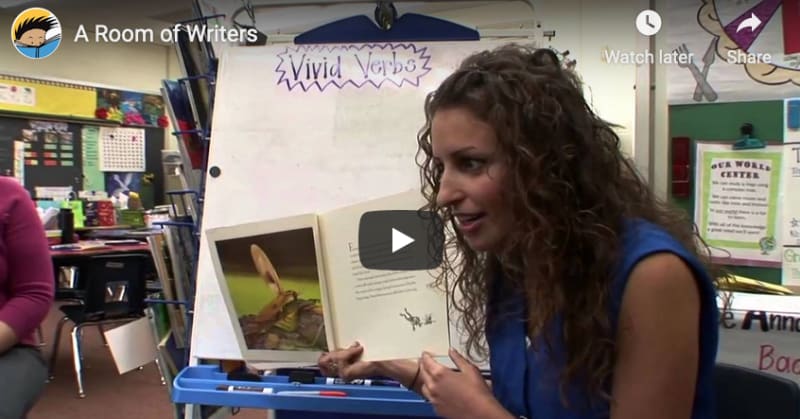
Knowledge
Not only does a writer need to know common structures, but they need to have awareness of the social nature of writing and a strong background knowledge of their topic. The purpose of writing is to communicate. To do this successfully, you need to be aware of who you are writing to, what it is you want them to know and/or feel, and how their perspective might differ from yours. You also need to know a topic well enough to be able to have anything to share.
- Background knowledge of the topic
- The function and purpose of reading and writing
- Knowing that readers and writers interact
- Understanding audience and different perspectives
Instructional Routines to Support Knowledge
- SECONDARY: Authentic Writing Strategy Sheet
- The function and purpose of reading and writing
- Evidence Based Practices (short description of each component of writing)
- The Dos Of Writing Instruction
- RAFT strategy: The purpose of writing and understanding the audience
- Promoting Preschoolers Emergent Writing: NAEYC (National Association for the Education of Young Children)
Self Regulation
To communicate effectively through writing, the writer must be aware of their purpose and monitor, plan, organize, and revise their efforts. They also need to maintain their motivation and persevere in the face of difficulties.
- Planning
- Organizing
- Monitoring
- Revising
Self Regulation: A Predictor of Academic Abilities
Instructional Routines to Support Self Regulation
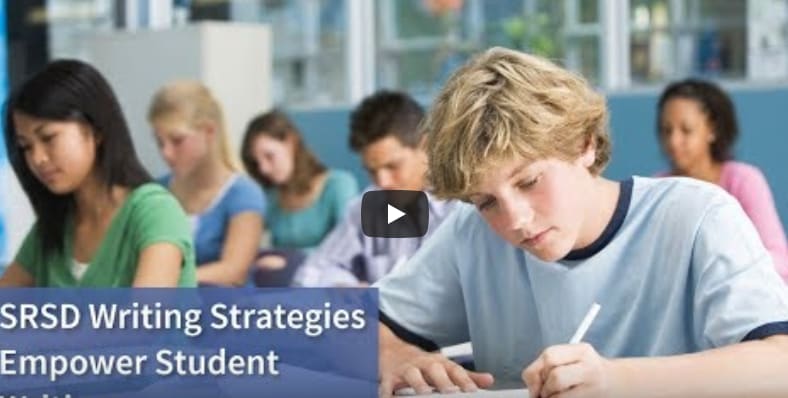
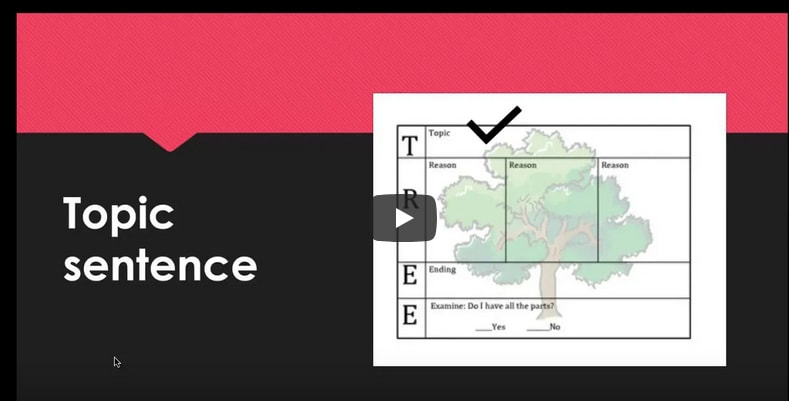
Critical Thinking
Often the act of writing involves the transformation of knowledge. Writers synthesize information they have found from multiple sources. They compare and contrast. They make arguments and cite their reasons. In order to have quality content, students must first be able to engage in the thinking skills needed for the assignment.
Teaching Elementary Students to be Effective Writers
Keystone Reading Comprehension Site
Instructional Routines to Support Critical Thinking
- Finding the most central idea
- Cause/effect
- Compare/contrast
- Generalize from examples
- Synthesize and integrate information
- Tech Tools to Support
Early Childhood: Critical Thinking-Building a Key Foundation for Language and Literacy Success
Data & Assessment
Classwide intervention should be considered when Universal Screening data indicates that ≤ 60% of the class is proficient in the following writing subtests:
- CBA (Curriculum Based Assessment)
- AIMsWEB: CWS, TWW, WSC
- Early Writing Measures
Classwide Intervention Considerations
- Were you consistent with implementing the classwide intervention?
- Did you or how will you monitor student progress?
- Did your class as a whole make progress on this skill?
- Should you embed this intervention or routine into your core instruction?
- Are there some students that continue to struggle? If so, read on…
Diagnostic Assessments to guide instructional planning
- Consider reviewing class wide writing samples to determine skills to be taught.
- Use commercially made diagnostic tools such as: simple sentence rubrics, 6+ 1 Writing rubrics, Curriculum Based Assessments (CBA), etc.
- Reading Rockets Writing Assessment resources
Intervention intensification strategies *Taken from Iowa Intervention System Guide (Appendix 17A)

Steve Graham: How to help struggling writers
Reading Rockets – Meet the Experts Series
Need for Accommodations or Assistive Technology?
- First determine what tasks the student struggles most: Use The Planning and Collaborating Document to help
- Then consider any accommodations that might be put in place:
- The rate of producing written work
- The volume of the work to be produced
- The complexity of the writing task
- The tools used to produce the written product: Download Graphic organizers
- The format of the product
- Finally consider Assistive Technology options:
Assistive Technology Tools: Writing (Reading Rockets Site)
Article that list some helpful assistive technology tools from Understood.org
Early Childhood
Early Literacy Resources
Please explore the resources below.
- Creative Curriculum
- Read it Again
- Get Ready to Read
- NAEYC Emergent Writing
- Reading Rockets
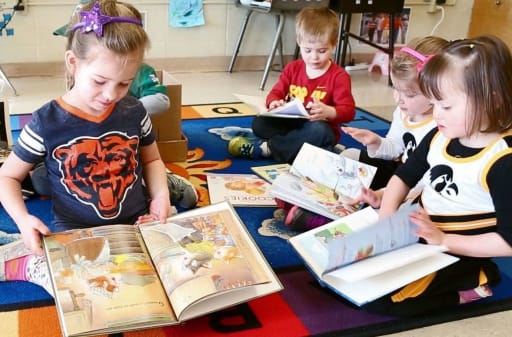
Iowa Early Learning Standards
Angie Squires
School Improvement Facilitator
asquires@keystoneaea.org
563-241-3347or 800-632-5918
Dyslexia
This is designed to be a portal of information to connect parents, educators, and students to the most reliable resources on the topic of Dyslexia.
Dyslexia…
- is a language processing disorder, NOT a reading disorder.
- brains are structured differently.
- is not an intellectual disability.
- can range from mild to profound (profound Dyslexia is rare).
- affects up to 20% of student population.
- is inherited.
Courtesy of International Dyslexia Association, 2016
Iowa Department of Education Dyslexia Webpage
Dyslexia Contact
Courtney Bentley
School Improvement Facilitator
cbentley@keystoneaea.org
563-447-0898 or 800-632-5918
